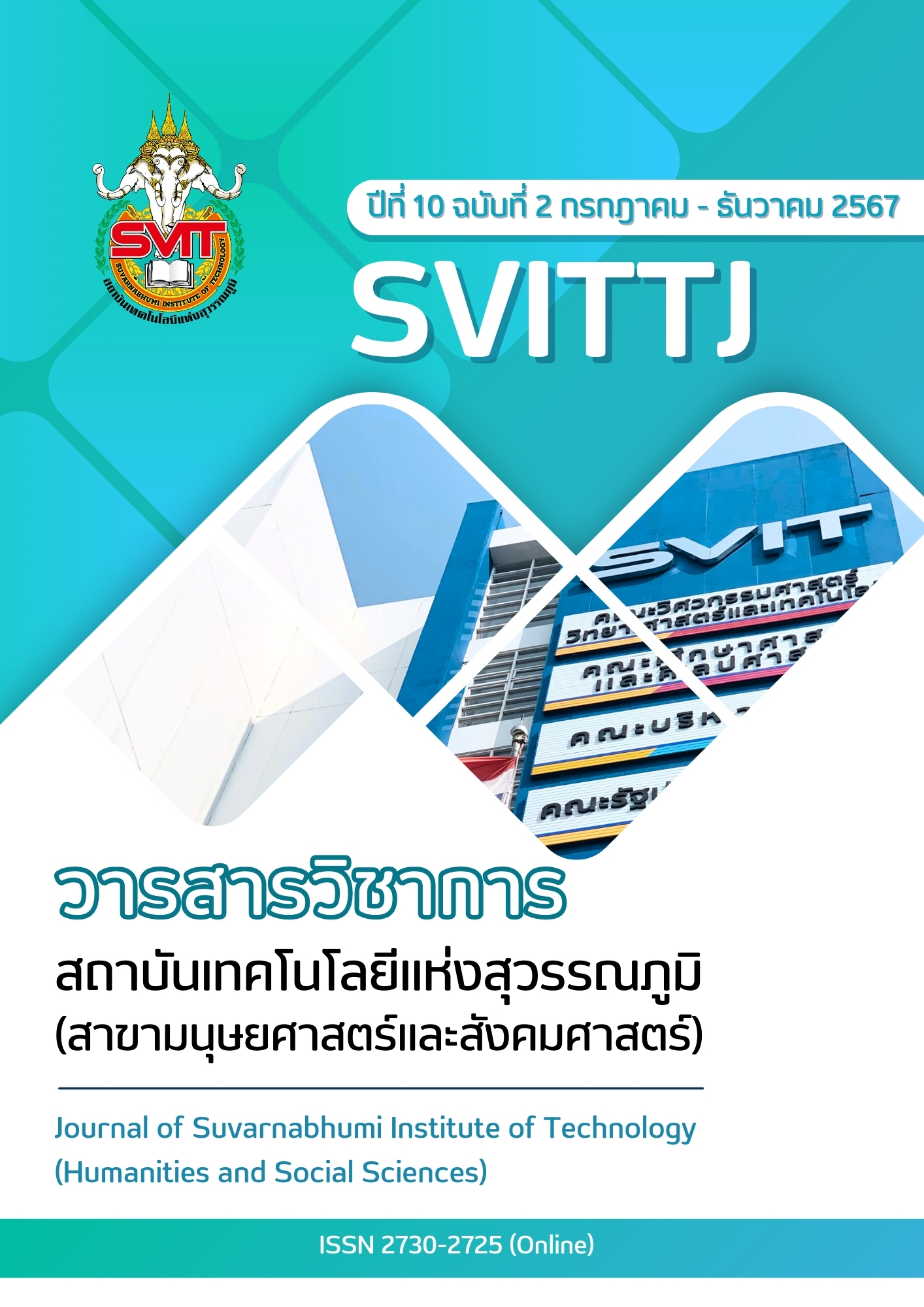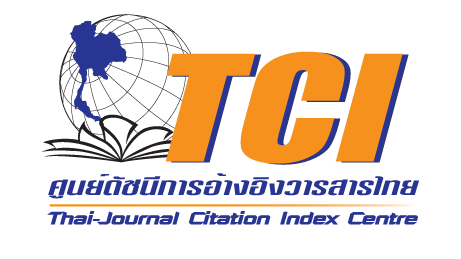DETERMINANTS OF BEHAVIOR INTENTIONS AND USE BEHAVIOR OF CHINESE TOURISTS TOWARDS TOURISM APPS
คำสำคัญ:
Social Influence, Behavior Intentions, Touristsบทคัดย่อ
This paper investigates the factors influencing Chinese tourists' behavior intention and use behavior of tourism apps. The framework considers perceived destination quality, satisfaction, memorability of a trip experience, performance expectancy, social influence, behavior intentions, and use behavior as variables. A quantitative research method (n=500) was used in this study to survey Chinese tourists who experienced the use of three tourism apps. Sampling methods included judgmental, quota, and snowball sampling. Data analysis included structural equation modeling and confirmatory factor analysis for model fit, reliability, and construct validity. Satisfaction, memorability of the trip experience, performance expectancy, and social influence significantly impact the behavioral intentions and usage behavior of Chinese tourists' app use, with performance expectancy exerting the strongest influence. Furthermore, perceived destination quality significantly influences satisfaction, while behavioral intentions significantly influence usage behavior. In conclusion, the results provide appropriate reference information, and promote more possibilities for Chinese tourist services to create more economic value.
เอกสารอ้างอิง
Ahn, J., & Kwon, J. (2020). Green hotel brands in Malaysia: Perceived value, cost, anticipated emotion, and revisit intention. Current Issues in Tourism, 23(12), 1559-1574. https://doi.org/10.1080/13683500.2019.1646715
Awang, Z. (2012). Structural equation modeling using AMOS graphic. Penerbit Universiti Teknologi MARA.
Bentler, P. M. (1990). Comparative fit indexes in structural models. Psychological Bulletin, 107(2), 238. https://doi.org/https://doi.org/10.1037/0033-2909.107.2.238
Cai, Y., Ma, J., & Lee, Y. S. (2020). How do Chinese travelers experience the Arctic? Insights from a hedonic and eudaimonic perspective. Scandinavian journal of hospitality and tourism, 20(2), 144-165. https://doi.org/10.1080/15022250.2020.1744185
Çelik, S., & Dedeoğlu, B. B. (2019). Psychological factors affecting the behavioral intention of the tourist visiting Southeastern Anatolia [Article]. Journal of Hospitality and Tourism Insights, 2(4), 425-450. https://doi.org/10.1108/JHTI-01-2019-0005
Chang, I. C., Chou, P. C., & Yeh, R. K. J. (2016). Factors influencing Chinese tourists' intentions to use the Taiwan Medical Travel App [Article]. Telematics and Informatics, 33(2), 401-409. https://doi.org/10.1016/j.tele.2015.09.007
Chen, K.-H., Huang, L., & Ye, Y. (2023). Research on the relationship between wellness tourism experiences cape and revisit intention: a chain mediation model. International Journal of Contemporary Hospitality Management, 35(3), 893-918. https://doi.org/10.1108/IJCHM-01-2022-0050
Cheng, V. T. P., & Pai, C.-K. (2020). A trip planning service acceptance model for young mainland Chinese tourists. Journal of Hospitality and Tourism Technology, 11(2), 327-342. https://doi.org/10.1108/JHTT-11-2017-0121
Chow, A. S. Y., Ma, A. T. H., & Wong, G. K. L. (2019). The Impacts of Place Attachment on Environmentally Responsible Behavioral Intention and Satisfaction of Chinese Nature-Based Tourists. Sustainability, 11(20), 5585. https://www.mdpi.com/2071-1050/11/20/5585
Chua, P. Y., Razaei, S., Gu, M., & Oh, Y. (2018). Elucidating social networking apps decisions. Nankai Business Review International, 9(2), 118-142. https://doi.org/10.1108/NBRI-01-2017-0003
Cong, L. C. (2016). A formative model of the relationship between destination quality, tourist satisfaction and intentional loyalty: An empirical test in Vietnam [Article]. Journal of Hospitality and Tourism management, 26, 50-62. https://doi.org/10.1016/j.jhtm.2015.12.002
Fornell, C., & Larcker, D. F. (1981). Evaluating structural equation models with unobservable variables and measurement error. Journal of marketing Research, 18(1), 39-50. https://doi.org/10.1177/002224378101800104
Gao, Z., Cheah, J.-H., & Jean, L. X. (2023). Can travel apps improve tourists’ intentions? Investigating the drivers of Chinese gen Y users’ experience. Journal of Vacation Marketing, 1(2), 11-20. https://doi.org/10.1177/13567667231152938
Gupta, K., & Arora, N. (2020). Investigating consumer intention to accept mobile payment systems through unified theory of acceptance model: An Indian perspective. South Asian Journal of Business Studies, 9(1), 88-114. https://doi.org/10.1108/SAJBS-03-2019-0037
Hair, E., Halle, T., Terry-Humen, E., & Calkins, J. (2006). Children's school readiness in the ECLS-K: Predictions to academic, health, and social outcomes in first grade. Early Childhood Research Quarterly, 21(4), 431-454. https://doi.org/10.1016/j.ecresq.2006.09.005
Hong, X., & Wu, Y. H. (2022). The use of AR to preserve and popularize traditional Chinese musical instruments as part of the formation of the tourist attractiveness of the national art of Guizhou province. Digital Scholarship in the Humanities, 37(2), 426-440. https://doi.org/10.1093/llc/fqab087
Hopwood, C. J., & Donnellan, M. B. (2010). How should the internal structure of personality inventories be evaluated? Personality and social psychology review, 14(3), 332-346. https://doi.org/10.1177/1088868310361240
Hosseini, S., Macias, R., & Garcia, F. A. G. (2023). Memorable tourism experience research: a systematic review of the literature. Tourism Recreation Research, 48(3), 465-479. https://doi.org/10.1080/02508281.2021.1922206
Kim, S. J. (2019). The effect of service convenience and mobile apps on consumer re-use in the service trade market: A focus on China medical tourist [Article]. Journal of Korea Trade, 23(4), 58-79. https://doi.org/10.35611/jkt.2019.23.4.58
Kline, R. B. (2015). Principles and practice of structural equation modeling (1st ed.). Guilford publications.
Lai, I. K. W. (2015). Traveler Acceptance of an App-Based Mobile Tour Guide. Journal of Hospitality & Tourism Research, 39(3), 401-432. https://doi.org/10.1177/1096348013491596
Le, C. C., & Dong, D. X. (2017). Factors affecting European tourists’ satisfaction in Nha Trang city: perceptions of destination quality. International Journal of Tourism Cities, 3(4), 350-362. https://doi.org/10.1108/IJTC-04-2017-0022
Li, M., Cai, L., & Qiu, S. (2016). A Value, Affective Attitude, and Tourist Behavioral Intention Model. Journal of China Tourism Research, 12(2), 179-195. https://doi.org/10.1080/19388160.2016.1225620
Li, T., & Chen, Y. (2019). Do Regulations Always Work? The Moderate Effects of Reinforcement Sensitivity on Deviant Tourist Behavior Intention. Journal of Travel Research, 58(8), 1317-1330. https://doi.org/10.1177/0047287518804679
Lin, L. P. L., Huang, S.-C. L., & Ho, Y.-C. (2020). Could virtual reality effectively market slow travel in a heritage destination?. Tourism Management, 78, 104027. https://doi.org/10.1016/j.tourman.2019.104027
Liu, Y., Negricea, L. C., & Li, Q. (2023). Exploring the Continuance Usage Intention of Travel Applications in the Case of Chinese Tourists. Journal of Hospitality and Tourism Research, 47(1), 6-32. https://doi.org/10.1177/1096348020962553
Ma, Y., Hardy, A., & Ooi, C.-S. (2020). Researching Chinese Tourists on the Move. Journal of China Tourism Research, 16(2), 214-229. https://doi.org/10.1080/19388160.2019.1607794
Ni, J., Rhim, A. H. R., Chiu, D. K. W., & Ho, K. K. W. (2022). Information search behavior among Chinese self-drive tourists in the smartphone era. Information Discovery and Delivery, 50(3), 285-296. https://doi.org/10.1108/IDD-05-2020-0054
Nunnally, J. C. (1978). Psychometric theory (2nd ed.). McGraw-Hill.
Rajaratnam, S. D., Nair, V., Sharif, S. P., & Munikrishnan, U. T. (2015). Destination quality and tourists’ behavioral intentions: rural tourist destinations in Malaysia. Worldwide Hospitality and Tourism Themes, 7(5), 463-472. https://doi.org/10.1108/WHATT-06-2015-0026
Sharma, S., Mukherjee, S., Kumar, A., & Dillon, W. R. (2005). A simulation study to investigate the use of cutoff values for assessing model fit in covariance structure models. Journal of Business Research, 58(7), 935-943. https://doi.org/10.1016/j.jbusres.2003.10.007
Shu, M., & Scott, N. (2014). Influence of Social Media on Chinese Students’ Choice of an Overseas Study Destination: An Information Adoption Model Perspective. Journal of Travel & Tourism Marketing, 31(2), 286-302. https://doi.org/10.1080/10548408.2014.873318
Sica, C., & Ghisi, M. (2007). The Italian versions of the Beck Anxiety Inventory and the Beck Depression Inventory-II: psychometric properties and discriminant power. Leading-Edge Psychological Tests and Testing Research (pp.27-50). NOVA Science.
Sparks, B., & Pan, G. W. (2009). Chinese Outbound tourists: Understanding their attitudes, constraints and use of information sources. Tourism management, 30(4), 483-494. https://doi.org/https://doi.org/10.1016/j.tourman.2008.10.014
Sthapit, E., Del Chiappa, G., Coudounaris, D., & Björk, P. (2019). Tourism experiences, memorability, and behavioral intentions: a study of tourists in Sardinia, Italy. Tourism Review, 75(3), 533-558. https://doi.org/https://doi.org/10.1108/TR-03-2019-0102
Sun, J., & Guo, Y. (2022). A New Destination on the Palm? The Moderating Effect of Travel Anxiety on Digital Tourism Behavior in Extended UTAUT2 and TTF Models [Original Research]. Frontiers in Psychology, 13, 965655 https://doi.org/10.3389/fpsyg.2022.965655
Tseng, L.-Y., Chang, J.-H., & Zhu, Y. L. (2021). What drives the travel switching behavior of Chinese Generation Z consumers. Journal of Tourism Futures, 1(1), 1-16. https://doi.org/10.1108/JTF-07-2020-0110
Tu, H. W. T., Guo, W. F., & Yan, M. (2020). The Relationship between Tour Guide Humor and Tourists’ Behavior Intention: A Cross-Level Analysis. Journal of Travel Research, 59(8), 1478-1492. https://doi.org/10.1177/0047287519883033
Vongurai, R. (2024). An Empirical Investigation of Factors Influencing Innovation and Organizational Performance among Logistics and Supply Chain Organizations in Thailand. The Journal of Distribution Science, 22(2), 1-10, https://doi.org/10.15722/jds.22.02.202402.1
Wang, C., Cui, W., Zhang, Y., & Shen, H. (2022). Exploring short video apps users’ travel behavior intention: Empirical analysis based on SVA-TAM model [Original Research]. Frontiers in Psychology, 13, 912177. https://doi.org/10.3389/fpsyg.2022.912177
Wang, S., Wang, J., Wan, L., & Wang, H. (2023). Social norms and tourists’ pro-environmental behaviors: Do ethical evaluation and Chinese cultural values matter? Journal of Sustainable Tourism, 31(6), 1413-1429. https://doi.org/10.1080/09669582.2022.2049805
Wang, X., & Zhang, C. (2020). Contingent effects of social norms on tourists’ pro-environmental behaviours: the role of Chinese traditionality. Journal of Sustainable Tourism, 28(10), 1646-1664. https://doi.org/10.1080/09669582.2020.1746795
Warsito, C. (2024). Performance of Cultural Tourism: Mediating Role of Perceived Destination Quality. Quality - Access to Success, 25(198), 342-350. https://doi.org/10.47750/QAS/25.198.36
Wu, J.-H., & Wang, Y.-M. (2006). Measuring KMS success: A specification of the DeLone and McLean's model. Information & management, 43(6), 728-739. https://doi.org/10.1016/j.im.2006.05.002
Wu, R., & Lee, J. H. (2017). The use intention of mobile travel apps by Korea-visiting Chinese tourists. Journal of Distribution Science, 15(5), 53-64. https://doi.org/10.15722/jds.15.5.201705.53
Wu, R.-Z., Lee, J.-H., & Tian, X.-F. (2021). Determinants of the Intention to Use Cross-Border Mobile Payments in Korea among Chinese Tourists: An Integrated Perspective of UTAUT2 with TTF and ITM. Journal of Theoretical and Applied Electronic Commerce Research, 16(5), 1537-1556. https://www.mdpi.com/0718-1876/16/5/86
Wu, X., & Lai, I. K. W. (2021). The acceptance of augmented reality tour app for promoting film-induced tourism: the effect of celebrity involvement and personal innovativeness. Journal of Hospitality and Tourism Technology, 12(3), 454-470. https://doi.org/10.1108/JHTT-03-2020-0054
Xia, L., Lee, T. J., & Kim, D. K. (2024). Relationships between motivation, service quality, tourist satisfaction, quality of life, and spa and wellness tourism. International Journal of Tourism Research, 26(1), e2624. https://doi.org/10.1002/jtr.2624
Yang, S., Lu, Y., Gupta, S., & Cao, Y. (2012). Mobile payment services adoption across time: An empirical study of the effects of behavioral beliefs, social influences, and personal traits. Computers in human behavior, 28(1), 129-142. https://doi.org/https://doi.org/10.1016/j.chb.2011.08.019
Zhang, H., Chen, W., Zhang, Y., Buhalis, D., & Lu, L. (2018). National Park visitors' car-use intention: A norm-neutralization model. Tourism Management, 69, 97–108. https://doi.org/10.1016/j.tourman.2018.06.001
Zhao, Q., Guanghui, J., & Yuting, Y. (2022). Multifunction changes of rural housing land in metropolitan suburbs from the perspective of farmer households’ land-use behavior. Land Use Policy, 119, 106206. https://doi.org/https://doi.org/10.1016/j.landusepol.2022.106206
ดาวน์โหลด
เผยแพร่แล้ว
ฉบับ
ประเภทบทความ
สัญญาอนุญาต
ลิขสิทธิ์ (c) 2024 สถาบันเทคโนโลยีแห่งสุวรรณภูมิ

อนุญาตภายใต้เงื่อนไข Creative Commons Attribution-NonCommercial-NoDerivatives 4.0 International License.
บทความที่ได้รับการตีพิมพ์เป็นลิขสิทธิ์ของวารสารวิชาการ สถาบันเทคโนโลยีแห่งสุวรรณภูมิ
ข้อความที่ปรากฏในบทความแต่ละเรื่องในวารสารวิชาการเล่มนี้เป็นความคิดเห็นส่วนตัวของผู้เขียนแต่ละท่านไม่เกี่ยวข้องกับสถาบันเทคโนโลยีแห่งสุวรรณภูมิ และคณาจารย์ท่านอื่นๆในสถาบันฯ แต่อย่างใด ความรับผิดชอบองค์ประกอบทั้งหมดของบทความแต่ละเรื่องเป็นของผู้เขียนแต่ละท่าน หากมีความผิดพลาดใดๆ ผู้เขียนแต่ละท่านจะรับผิดชอบบทความของตนเองแต่ผู้เดียว





